Writing at the college level often means integrating ideas from published sources into your own arguments. To do this, you can use direct quotes, or you can paraphrase and summarize. Paraphrasing and summarizing involve condensing the original source to focus your reader’s attention on the specific ideas that support your argument. Generally, paraphrasing and summarizing are considered more sophisticated than quoting because condensing the original source in those ways require a deeper understanding of the original source than simply quoting.
Summarizing
A summary is an overview of a text. The main idea is given, but details, examples and formalities are left out. Used with longer texts, the main aim of summarizing is to reduce or condense a text to its most important ideas.
Why use a summary?
- To outline the main points of someone else’s work in your own words, without the details or examples.
- To include an author’s ideas using fewer words than the original text.
- To briefly give examples of several differing points of view on a topic.
- To support claims in, or provide evidence for, your writing.
To write a good summary, you should follow this procedure:
- Read the article to find the thesis statement. Read each section a few times to find the topic sentence for each paragraph and the supporting details within this paragraph.
- Take notes in your own words: write down any significant fact or detail in your own words to minimize the risk of plagiarizing the article/essay you have to summarize.
- Summarize each paragraph to make sure you know what its main point is.
- Include the thesis and the writer’s full name (or simply the last name) in the introduction.
- Review your notes to provide main supporting details as they appear in the paragraphs. Only write information that is crucial to understand the content of the article/essay.
- In your conclusion, restate the conclusion drawn by the writer of the original.
- Always use the writer’s tag to indicate that the information does not come from you. For example, include phrases like “Jones believes;” “Jones finds that;” “Jones expresses disbelief about.”
Paraphrasing
Paraphrasing is a way of presenting a text, keeping the same meaning, but using different words and phrasing. Paraphrasing is used with short sections of text, such as sentences or paragraphs.
Why use paraphrasing?
- To rewrite someone else’s ideas without changing the meaning.
- To express someone else’s ideas in your own words.
- To support claims in, or provide evidence for, your writing.
To write good paraphrasing, you should follow this procedure:
- Read the original text until you understand fully its meaning.
- Set the original aside or close the book and write down what you remember about the text.
- Check your version against the original to make sure you express the essential information accurately.
- Use quotation marks to indicate any phrase or concept you borrowed from the original.
- Record the source, with its page number, so you can easily indicate it if you need to incorporate it later into an essay.
Examples
Original Passage: “Students frequently overuse direct quotation in taking notes, and as a result they overuse quotations in the final [research] paper. Probably only about 10% of your final manuscript should appear as directly quoted matter. Therefore, you should strive to limit the amount of exact transcribing of source materials while taking notes.” Lester, James D. Writing Research Papers. 2nd ed. (1976): 46-47.
Unacceptable Use of the Source: Students often use too many direct quotations when they take notes, resulting in too many of them in the final research paper. In fact, probably only about 10% of the final copy should consist of directly quoted material. So it is important to limit the amount of source material copied while taking notes.
NOTE: First, this passage has no citation. Furthermore, it uses too many words/phrases from the original and fails to change the structure of the sentences and paragraph.
Acceptable Paraphrase: In research papers students often quote excessively, failing to keep quoted material down to a desirable level. Since the problem usually originates during note taking, it is essential to minimize the material recorded verbatim (Lester 46-47).
Acceptable Summary: Students should take just a few notes in direct quotation from sources to help minimize the amount of quoted material in a research paper (Lester 46-47).
Michael | 2018
This work is licensed under the Creative Commons Attribution-NonCommercial-ShareAlike 4.0 International License. To view a copy of this license, visit http://creativecommons.org/licenses/by-nc-sa/4.0/.
What is a Library Database?
Materials in library databases have either gone through the peer review process or have been reviewed by a professional editor. Library databases are often tailored toward a specific audience, or they deal with a specific subject.
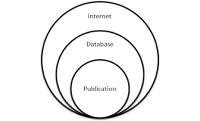
Most library databases provide access to hundreds or thousands of magazines, newspapers or scholarly journals. Each of those newspapers, magazines or journals contain many articles. Other databases provide access to reports or other information on a specific topic.
Public and academic libraries pay for database subscriptions and provide access to their users for free. To access the MC Library Databases, you must first go to the MC Library website. If you are accessing the site from an off-campus computer, you will need your MC login information.
Developing Search Terms & Keywords
There’s a lot of information out there. The trick is finding the good stuff. Whether you’re searching the free web or a database, thinking about search terms to search for your topic can save you time and help you find better results. You may find it helpful to keep a written list of search terms, which you can add to as you go along.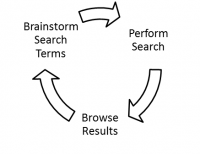
The research process is dynamic and ongoing. As you search, you may add to your search terms list, and this may help you to develop or further define your topic.
The first step of brainstorming search terms is to look at your topic sentence and pick out the words that represent the main ideas. Use these words to brainstorm synonyms and other search terms to add to your list. Consider the time period that you’re studying and how it might impact your terms. Think about how different people in different positions might represent your topic and terms. It can also be helpful to think about ideas and subtopics related to your main idea terms.
Exact Phrase Searching
To look for an exact phrase, type your phrase within quotation marks (” “). The results will contain the exact words in the quotation marks as a phrase, rather than as individual terms.
Example: “attention deficit disorder” vs. attention + deficit + disorder
Using Truncation
Using an asterisk (*) or question mark (?) at the end of a root word (known as truncation or stemming), allows you to retrieve results containing any form of the root word. Most databases use the asterisk (*) as the truncation symbol. Check the Help screen of the database you are using for the truncation symbol.
Example: teen* = teen, teens, teenage, teenager, teenagers
Boolean Operators
This is based on connecting keywords with three basic operators: AND, OR and NOT.
| AND
The database or search engine will only retrieve those articles or web pages that contain both words.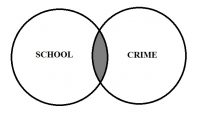
This will NARROW your search and DECREASE search results.
Example: school AND crime |
|
| OR
The database or search engine will retrieve those articles or web pages that contain at least one of these words.
This will BROADEN your search and INCREASE search results.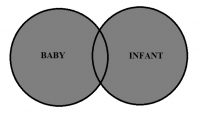
Example: baby OR infant |
|
| NOT
The database or search engine will exclude that word from your search.
This will ELIMINATE unintended meanings in your results.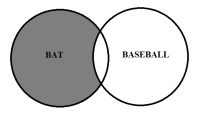
Example: bat NOT baseball |
|
Combining Boolean Operators
Use parentheses ( ) to keep combination searches in order. In the example below, articles or web pages retrieved will contain the word law and at least one of the words in parentheses.
Example: law AND (ecstasy OR mdma) 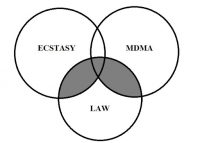 |
|
Kayla | 2014
This work is licensed under the Creative Commons Attribution-NonCommercial-ShareAlike 4.0 International License. To view a copy of this license, visit http://creativecommons.org/licenses/by-nc-sa/4.0/.
When used properly, quotations can add authority, persuasion, and strength to your argument. However, quotations should only supplement your argument. Don’t make an argument of only quotations – then it’s not your argument. Your reader has come to you to hear your argument and your explanation of the topic. Each direct quotation should be followed by one or more sentences of analysis, explaining what’s interesting, significant, or helpful about the quotation. Quotations cannot just stand alone!
Getting the hang of using quotations correctly can be tricky. The guidelines below will help you. Remember that all quotations must be properly cited.
What is a Direct Quotation?
A direct quotation is when you take another person’s words and place them in your own document. These must always be placed inside quotation marks and given appropriate attribution (MLA, APA, Chicago, etc).
When should I quote?
Not all evidence needs to be presented in the form of direct quotation. Often, you can convey information more efficiently and integrate it more smoothly into your own writing by paraphrasing, rather than using direct quotation. Only use a direct quotation when one of these statements is true:
- The passage is particularly effective, memorable, or well written.
- Your analysis will focus on specific words or phrases in the passage.
- You want to emphasize the source’s opinion, especially if the passage clarifies a difficult or contested claim.
- You are quoting an authority who will lend weight to your argument.
How should I introduce a direct quotation?
When you use a direct quotation, you need to integrate it into the rest of the paragraph and to let your reader know whose words you are quoting (and why they should care what that person has to say). The first time you introduce a quotation and its source you should include some basic contextual information in a signal phrase or signal verb. These signals can appear at the beginning, middle, or end of a direct quote. Different words can imply different attitudes on the part of both speaker and author towards a quotation.
“This evidence is overwhelming at this point,” journalist and cookbook author Mark Bittman explains. “You eat more plants, you eat less other stuff, you live longer” (70).
→ This signal phrase/verb convey a sense of trust in the author.
Journalist and cookbook author Mark Bittman flippantly hypothesizes, “You eat more plants, you eat less other stuff, you live longer” (70).
→ This signal phrase/verb convey doubt about the author’s claims.
How do I format a direct quotation correctly?
First, determine whether or not the quote should be formatted as a “short quote” or a “block quote.” This varies depending on the citation style you are using. MLA style considers a quote that takes up more than four lines of your document to be a block quote. For Chicago, the length is two lines. For APA, the length for block quotes is more than 40 words.
Short Quotes:
- Incorporate the quote into your own grammatical structure using signal phrases.
- Place quotation marks (“”) around the quoted words.
- Add attribution using the appropriate citation style for your document (MLA, APA, etc.) Ask your professor for guidelines about which style to use.
Block Quotes:
- Make sure you need the entire quote before inserting a block quote into your document. Ask yourself if there are portions of the original that could be removed without interfering with the meaning of the quote.
- Place a colon at the end of the signal phrase or sentence preceding the quote.
- Check the appropriate style guide for the rules regarding indentation and spacing.
Can I change a quote? When and how?
Ellipses: Sometimes, you may only need to use part of a lengthy quotation. Ellipses indicate to your reader that you have removed part of the original quotation:
Mark Twain’s disdain for Jane Austen is well known. He declared in an 1898 letter, “I haven’t any right to criticise books, and I don’t do it except when I hate them. I often want to criticise Jane Austen. . . . Every time I read ‘Pride and Prejudice’ I want to dig her up and beat her over the skull with her own shin-bone.”
Brackets: Sometimes you need to change the tense of a verb or clarify or change a pronoun or name. Use square brackets to indicate any changes you make to the original quotation:
“He wanted to change the way people look at race relations.”
→ According to political pundits,“[Barack Obama] wanted to change the way people look at race relations (Collins 39).
Kaylan | 2016 This work is licensed under the Creative Commons Attribution-NonCommercial-ShareAlike 4.0 International License. To view a copy of this license, visit http://creativecommons.org/licenses/by-nc-sa/4.0/.
- Create your Bibliography page before you start writing your essay. Include all the sources you read, not just the ones you actually reference in the essay.
- Determine what type of source you are looking at. This is the hardest and most important part of citation. For example, there are significant differences between online and database sources.
- Use a style manual or style handbook to create the bibliography entries. No one memorizes the rules, especially since they are updated every few years to keep up with new technology. Instead, learn how to use the style manual.
- Organize your list alphabetically. If you have two authors with the same last name, look at their first names. If you have two sources by the same author, look at the title, and so on.
- Format the list using hanging indents. This indent style requires that the first line of the citation is left-aligned, but any additional lines are indented by ½ inch.
-
If you are working with a large number of sources, consider making an Annotated Bibliography.
-
Format your essay using Chicago document style.
-
Create in-text citations (footnotes OR endnotes).
- The first time you reference any source, either with a direct quote or a paraphrase, you should use a signal phrase along with the footnote/endnote to indicate the credibility of the source. For example, you might write: Respected writer Shelby Foote, while agreeing that the report was “largely” fabricated, points out that the “casualty figures indicate …”7
- After the first use of a source, you may choose between either signal phrases with footnotes/endnotes or footnotes/endnotes-only for your in-text citations.
- The first time you use a source, the footnote/endnote must include the author’s name, title, publication information, and page number.
- Peter Burchard, One Gallant Rush: Robert Gould Shaw and His Brave Black Regiment (New York: St. Martin’s, 1965), 85.
- Any subsequent references can be in short form, with only author’s name, shortened title, and page number.
- Burchard, One Gallant Rush, 31.
- If you reference a single work twice in a row, you may use the latin term Ibid. and the page number for the second note.
- Jack Hurst, Nathan Bedford Forrest: A Biography (New York: Knopf, 1993), 8.
- Ibid., 174.
| Type |
Bibliography |
Footnote or Endnote |
| Book (Print) |
Woods, Mary N. Beyond the Architect’s Eye: Photographs and the American Built Environment. Philadelphia: University of Pennsylvania Press, 2009. |
1. Mary N. Woods, Beyond the Architect’s Eye: Photographs and the American Built Environment (Philadelphia: University of Pennsylvania Press, 2009). |
| e-Book |
Tolstoy, Leo. War and Peace. Translated by Richard Pevear and Larissa Volokhonsky. New York: Knopf, 2007. Kindle edition. |
3. Leo Tolstoy, War and Peace, trans. Richard Pevear and Larissa Volokhonsky (New York: Knopf, 2007), Kindle edition, vol. 1, pt. 1, chap. 3. |
| Anthology |
Hurston, Zora Neale. “From Dust Tracks on a Road.” In The Norton Book of American Autobiography, edited by Jay Parini, 333-43. New York: Norton, 1999. |
13. Zora Neale Hurston, “From Dust Tracks on a Road,” in The Norton Book of American Autobiography, ed. Jay Parini (New York: Norton, 1999), 336. |
| Introduction, Preface, Afterword |
DeMille, Nelson. Foreword to Flag: An American Biography, by Marc Leepson, xi-xiv. New York: Thomas Dunne, 2005. |
14. Nelson DeMille, foreword to Flag: An American Biography, by Marc Leepson (New York: Thomas Dunne, 2005), xii. |
| Journal (Database) |
Leung, Constant. “Language and Content in Bilingual Education.” Linguistics and Education 16, no. 2 (2005): 238-52. doi:10.1016/j.linged.2006.01.004. |
24. Constant Leung, “Language and Content in Bilingual Education,” Linguistics and Education 16, no. 2 (2005): 239, doi:10.1016/j.linged.2006.01.004. |
| Magazine (Online) |
Mieszkowski, Katharine. “A Deluge Waiting to Happen.” Salon, July 3, 2008. http://www.salon.com/news/feature/2008/07/03/floods/index.html. |
26. Katharine Mieszkowski, “A Deluge Waiting to Happen,” Salon, July 3, 2008, http://www.salon.com/news/feature/2008/07/03/floods/index.html |
| Magazine (Database) |
“Facing Facts in Afghanistan.” National Review, November 2, 2009, 14. Expanded Academic ASAP (A209905060). |
27. Facing Facts in Afghanistan,” National Review, November 2, 2009, 14, Expanded Academic ASAP (A209905060). |
| Newspaper (Online) |
McManus, Doyle. “The Candor War.” Chicago Tribune, July 29, 2010. http://www.chicagotribune.com/. |
29. Doyle McManus, “The Candor War,” Chicago Tribune, July 29, 2010, http://www.chicagotribune.com/. |
| Newspaper (Database) |
Levy, Clifford J. “In Kyrgyzstan, Failure to Act Adds to Crisis.” New York Times, June 18, 2010. General OneFile (A229196045). |
30.Clifford J. Levy, “In Kyrgyzstan, Failure to Act Adds to Crisis,” New York Times, June 18, 2010, General OneFile (A229196045). |
| Work of Art |
Siskind, Aaron. Untitled (The Most Crowded Block). Gelatin silver print, 1939. Kemper Museum of Contemporary Art, Kansas City, MO. |
48. Aaron Siskind, Untitled (The Most Crowded Block), gelatin silver print, 1939, Kemper Museum of Contemporary Art, Kansas City, MO. |
| Govt. Document |
U.S. Department of State. Foreign Relations of the United States: Diplomatic Papers, 1943. Washington, DC: GPO, 1965. |
40. U.S. Department of State, Foreign Relations of the United States: Diplomatic Papers, 1943 (Washington, DC: GPO, 1965), 562. |
Kayla | 2016
This work is licensed under the Creative Commons Attribution-NonCommercial-ShareAlike 4.0 International License. To view a copy of this license, visit http://creativecommons.org/licenses/by-nc-sa/4.0/.
For one of the clearest explanations of MLA 8th Edition citation style, download SVSU’s Writing Center guide: MLA 8th Edition Handout.
What is an annotated bibliography?
A bibliography is a list of sources (books, journals, web sites, periodicals, etc.) you have used for researching a topic. Bibliographies are sometimes called “References” or “Works Cited” depending on the style format you are using. A bibliography usually just includes the bibliographic information (i.e., the author, title, publisher, etc.).
An annotation is a summary and/or evaluation. Therefore, an annotated bibliography includes a summary and/or evaluation of each of the sources. Depending on your project or the assignment, your annotations may do one or more of the following.
- Summarize: Some annotations merely summarize the source. What are the main arguments? What is the point of this book or article? What topics are covered? If someone asked what this article/book is about, what would you say? The length of your annotations will determine how detailed your summary is.
- Assess: After summarizing a source, it may be helpful to evaluate it. Is it a useful source? How does it compare with other sources in your bibliography? Is the information reliable? Is this source biased or objective? What is the goal of this source?
- Reflect: Once you’ve summarized and assessed a source, you need to ask how it fits into your research. Was this source helpful to you? How does it help you shape your argument? How can you use this source in your research project? Has it changed how you think about your topic?
Your annotated bibliography may include some of these, all of these, or even others. If you’re doing this for a class, you should get specific guidelines from your instructor.
Why should I write an annotated bibliography?
To learn about your topic: Just collecting sources for a bibliography is useful, but when you have to write annotations for each source, you’re forced to read each source more carefully. You begin to read more critically instead of just collecting information. At the professional level, annotated bibliographies allow you to see what has been done in the literature and where your own research or scholarship can fit. Writing an annotated bibliography can help you gain a good perspective on what is being said about your topic. By reading and responding to a variety of sources on a topic, you’ll start to see what the issues are, what people are arguing about, and you’ll then be able to develop your own point of view.
To help other researchers: Extensive and scholarly annotated bibliographies are sometimes published. They provide a comprehensive overview of everything important that has been and is being said about that topic. You may not ever get your annotated bibliography published, but as a researcher, you might want to look for one that has been published about your topic.
What is the format?
The format of an annotated bibliography can vary, so if you’re doing one for a class, it’s important to ask for specific guidelines. Generally, annotated bibliographies will be formatted with the following pieces:
The bibliographic information: The bibliographic information of the source (the title, author, publisher, date, etc.) is written in the academic style used in your course.
The annotations: The annotations for each source are written in paragraph form. The lengths of the annotations can vary significantly from a couple of sentences to a couple of pages. The length will depend on the purpose. If you’re just writing summaries of your sources, the annotations may not be very long. However, if you are writing an extensive analysis of each source, you’ll need more space.
Example
Holland, Suzanne. The Human Embryonic Stem Cell Debate: Science, Ethics, and Public Policy. Boston: MIT Press, 2001. Print.
This is the annotation of the above source, which is formatted according to MLA 2009 (7thed.) guidelines for the bibliographic information listed above. If one were really writing an annotation for this source, one would offer a brief summary of what this book says about stem cell research.
After a brief summary, it would be appropriate to assess this source and offer some criticisms of it. Does it seem like a reliable and current source? Why? Is the research biased or objective? Are the facts well documented? Who is the author? Is she qualified in this subject? Is this source scholarly, popular, some of both?
The length of your annotation will depend on the assignment or on the purpose of your annotated bibliography. After summarizing and assessing, you can now reflect on this source. How does it fit into your research? Is this a helpful resource? Too scholarly? Not scholarly enough? Too general/specific? Since “stem cell research” is a very broad topic, has this source helped you to narrow your topic?
Vanessa Flora-Nakoski | This work is licensed under the Creative Commons Attribution-NonCommercial-ShareAlike 4.0 International License. To view a copy of this license, visit http://creativecommons.org/licenses/by-nc-sa/4.0/.
To download this page as a PDF, click this link: Annotated Bibliographies_PDF





